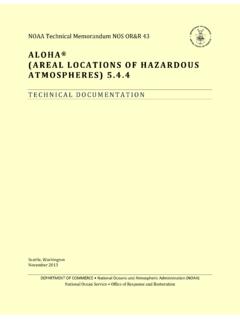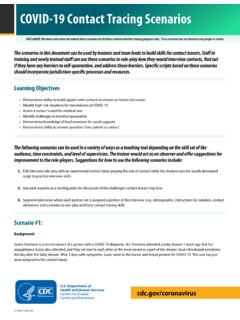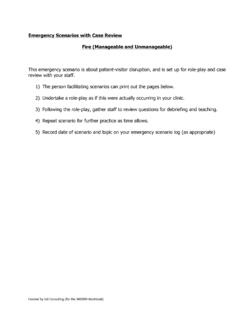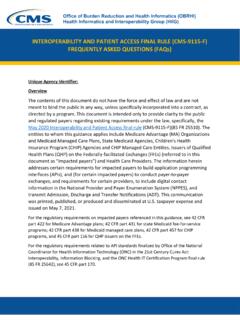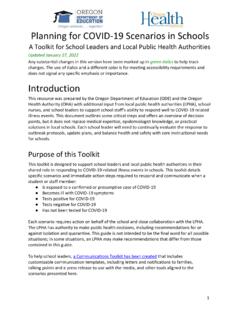Transcription of ALOHA Example Scenarios
1 The CAMEO Software Suite ALOHA Example Scenarios September 2016 National Oceanic and Atmospheric Administration Office of Response and Restoration Emergency Response Division Seattle, Washington UNITED STATES ENVIRONMEIONAGENCY Environmental Protection Agency Office of Emergency Management Washington, This document contains three step-by-step fictional ALOHA Example Scenarios . You can complete the first two Scenarios using only ALOHA . To complete the third scenario, you ll also need the latest MARPLOT mapping application. If you have questions about ALOHA , you can email the ALOHA Specialist at ALOHA Examples Example 1: A Tank Source (Puddle and Pool Fire) .. 3 Part 1: Modeling a Toxic Vapor Cloud .. 3 Part 2: Modeling a Pool Fire .. 15 Example 2: A Tank Source (Multiple Scenarios ) .. 20 Part 1: Modeling a BLEVE .. 20 Part 2: Modeling a Flash Fire or Vapor Cloud Explosion.
2 27 Part 3: Modeling a Jet Fire .. 37 Example 3: A Direct Source and a MARPLOT Map .. 40 ~ 2 ~ Example 1: A Tank Source (Puddle and Pool Fire) In a small industrial park outside Baton Rouge, Louisiana, a 500-gallon, 4-foot-diameter, vertical tank contains liquid benzene. On June 20, 2016, at 10:30 local time, a security guard discovers that liquid is leaking out of the tank through a 6-inch circular hole located 10 inches above the bottom of the tank. He also sees that the liquid is flowing onto a paved area in the industrial park. The guard thinks that the tank has just been filled that evening. The temperature on scene is 80 F, with the wind from the southwest at 7 miles per hour (as measured at a height of 10 meters by a fixed meteorological tower at the site). The sky is more than half covered by clouds and the humidity is about 75 percent.
3 A thunderstorm is approaching from the southwest. There is no low-level inversion. There are very few buildings in the industrial park and a large grassy field is located to the northeast of the industrial park. The Local Emergency Planning Committee has requested that on-scene responders use ERPG-2 concentrations to define the toxic endpoints in their analysis of benzene hazards. In this Example scenario, you ll determine: 1. Distance to the ERPG-2 level if the puddle evaporates and forms a toxic vapor cloud. 2. Thermal radiation threat if a lightning strike ignites the puddle and forms a pool fire. Example 1, Part 1: Modeling a Toxic Vapor Cloud Choosing a Location and a Chemical 1. Start ALOHA . 2. Read the list of ALOHA s limitations (click for more details), then click OK. 3. Select Location from the SiteData menu. A Location Information dialog box appears with a list of the names of cities included in ALOHA s location library.
4 4. The industrial park is located outside Baton Rouge, Louisiana. Type the characters ba to quickly move to the section of the list containing names beginning with ba. Scroll down a little farther until you see BATON ROUGE, LOUISIANA. Click on this name to highlight it, then click Select. ~ 3 ~ 5. Select Date & Time from the SiteData menu. A Date and Time Options dialog box appears. 6. The release occurs at 10:30 on June 20, 2016. Select the Set a constant time option. Enter the month, day, year, hour, and minute for this scenario. ALOHA requires you to convert the time of day into 24-hour time (click Help to learn how to convert time values). Click OK. 7. To choose the chemical that is being released benzene select Chemical from the SetUp menu. A Chemical Information dialog box appears with a list of the chemicals in ALOHA s chemical library.
5 8. Select Pure Chemicals at the top of the window (this should be the default). Find BENZENE in the list (type the character b to locate benzene more rapidly in the list), click on this name, then click Select. ~ 4 ~ Entering Weather Information and Ground Roughness Now that you ve selected the location, time, and chemical, you must provide information about weather conditions and ground roughness. 1. In the SetUp menu, point to Atmospheric, then select User Input. The first Atmospheric Options dialog box appears. 2. The wind is travelling from the southwest at a speed of 7 miles per hour. Type 7 in the wind speed box, then select mph. Type SW in the wind direction box. 3. The wind conditions are measured at a height of 10 meters. Select the tower icon in the Measurement Height section. Notice that ALOHA has filled in a value of 10 meters. 4.
6 There are very few buildings in the industrial park and a large grassy field is located to the northeast (the area where the wind would blow the toxic vapor cloud). Select the Open Country ground roughness option. 5. The sky is more than half covered by clouds. Under Select Cloud Cover, choose the second option from the left (the option between the complete cover and partly cloudy options). Notice that ALOHA has filled in a value of 7. Click OK. The second Atmospheric Options dialog box appears. ~ 5 ~ 6. The air temperature is 80 F. Type 80 in the air temperature box, then select F. 7. ALOHA uses the wind speed, cloud cover, and date and time information that you ve entered to automatically select atmospheric Stability Class D, representing conditions of neutral atmospheric stability. (Click Help for more details about stability classes and atmospheric stability.)
7 8. There is no low-level inversion. Check to be sure that No Inversion is selected. 9. The relative humidity is about 75 percent. Choose the second option from the left (the option between the wet and medium options). Notice that ALOHA has filled in a value of 75 percent. Click OK. The information that you have entered into ALOHA appears in the Text Summary. Ignore ALOHA s estimate of building exchange rate, since you re not considering infiltration into buildings. ~ 6 ~ Describing the Release Now you re ready to enter information about the release itself that is, to set the source for this release. 1. The benzene is leaking from a tank. In the SetUp menu, point to Source, then select Tank. A Tank Size and Orientation dialog box appears. 2. The benzene is stored in a 500-gallon, 4-foot-diameter, vertical tank. Select Vertical cylinder. Type 500 in the volume box, then select gallons.
8 Type 4 in the diameter box, then select feet. Notice that ALOHA automatically calculates the tank length. Click OK. A Chemical State and Temperature dialog box appears. 3. The benzene is stored in the tank as a liquid (notice in the Text Summary that it has a boiling point of F, which is well above the ambient temperature). Select the Tank contains liquid option. Check to be sure that Chemical stored at ambient temperature is selected. Click OK. A Liquid Mass or Volume dialog box appears. ~ 7 ~ 4. The security guard thinks the 500-gallon tank was filled that evening, so the most conservative estimate you can make is that the tank is 100 percent full. Either (a) type 100 in the % full by volume box, (b) type 500 in the liquid volume box, then click gallons, or (c) scroll the liquid level bar to the top of the tank diagram. Notice that ALOHA fills in the other values.
9 Click OK. A Type of Tank Failure dialog box appears. 5. Initially, the benzene is leaking from a hole in the tank, but it is not burning. Choose the Leaking tank, chemical is not burning and forms an evaporating puddle option. Click OK. An Area and Type of Leak dialog box appears. ~ 8 ~ 6. The benzene is leaking from a 6-inch circular hole. Check to be sure that Circular opening is selected. Type 6 in the opening diameter box and select inches. Choose the Hole option. Click OK. A Height of the Tank Opening dialog box appears. 7. The hole is 10 inches above the bottom of the tank. Type 10 in the bottom of the leak box and select in. Notice that ALOHA fills in the other values. Click OK. A Puddle Parameters dialog box appears. ~ 9 ~ 8. The liquid benzene is flowing onto a paved area in the industrial park. a. Select the Concrete ground type.
10 B. Since you have no information about the ground temperature, select Use air temperature (select this if unknown). c. Because the product is flowing onto a paved area, it is probably not contained by a dike, so it will continue spreading outward until it reaches a minimum thickness. Under the Input maximum puddle diameter or area heading, click Unknown. ALOHA will calculate the area for you based on the release information you provided (up to a maximum diameter of 200 meters for spills on land). d. Click OK. The source strength information that you have entered and the results of ALOHA s source strength calculations appear in the Text Summary. ALOHA estimates that the release of vapor into the atmosphere lasts for about 46 minutes, and that the maximum amount of vapor released at any one time is pounds per minute (this is the Maximum Average Sustained Release Rate).
